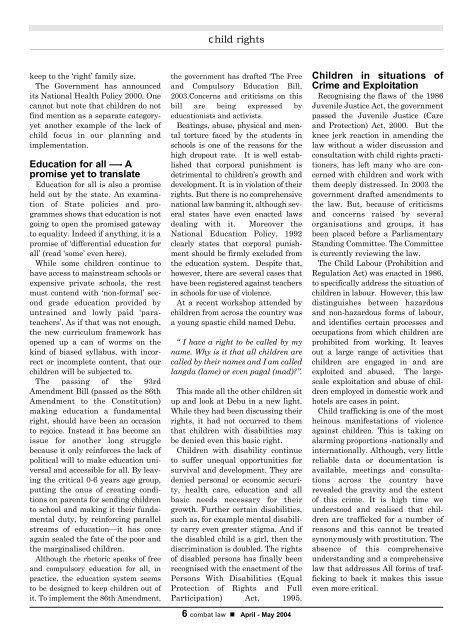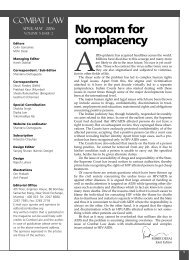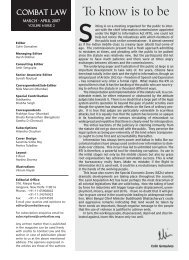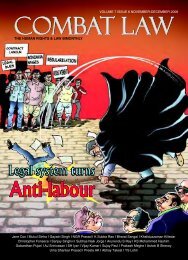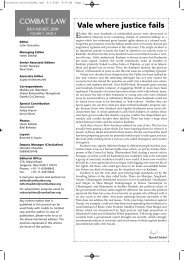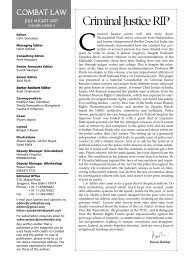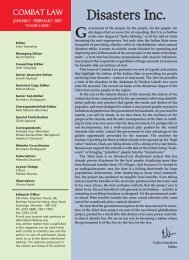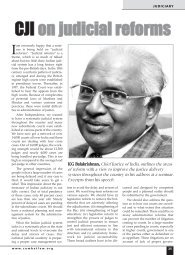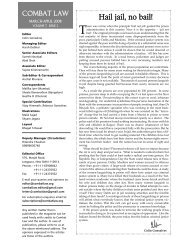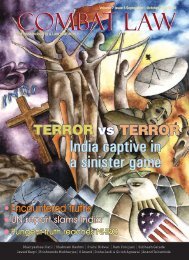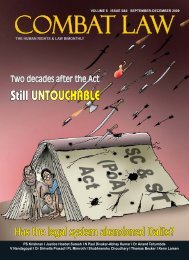PDF, 1.1MB - Combat Law
PDF, 1.1MB - Combat Law
PDF, 1.1MB - Combat Law
You also want an ePaper? Increase the reach of your titles
YUMPU automatically turns print PDFs into web optimized ePapers that Google loves.
child rightskeep to the ‘right’ family size.The Government has announcedits National Health Policy 2000. Onecannot but note that children do notfind mention as a separate categoryyetanother example of the lack ofchild focus in our planning andimplementation.Education for all —- Apromise yet to translateEducation for all is also a promiseheld out by the state. An examinationof State policies and programmesshows that education is notgoing to open the promised gatewayto equality. Indeed if anything, it is apromise of ‘differential education forall’ (read ‘some’ even here).While some children continue tohave access to mainstream schools orexpensive private schools, the restmust contend with ‘non-formal’ secondgrade education provided byuntrained and lowly paid ‘parateachers’.As if that was not enough,the new curriculum framework hasopened up a can of worms on thekind of biased syllabus, with incorrector incomplete content, that ourchildren will be subjected to.The passing of the 93rdAmendment Bill (passed as the 86thAmendment to the Constitution)making education a fundamentalright, should have been an occasionto rejoice. Instead it has become anissue for another long strugglebecause it only reinforces the lack ofpolitical will to make education universaland accessible for all. By leavingthe critical 0-6 years age group,putting the onus of creating conditionson parents for sending childrento school and making it their fundamentalduty, by reinforcing parallelstreams of education—it has onceagain sealed the fate of the poor andthe marginalised children.Although the rhetoric speaks of freeand compulsory education for all, inpractice, the education system seemsto be designed to keep children out ofit. To implement the 86th Amendment,the government has drafted ‘The Freeand Compulsory Education Bill,2003.Concerns and criticisms on thisbill are being expressed byeducationists and activists.Beatings, abuse, physical and mentaltorture faced by the students inschools is one of the reasons for thehigh dropout rate. It is well establishedthat corporal punishment isdetrimental to children’s growth anddevelopment. It is in violation of theirrights. But there is no comprehensivenational law banning it, although severalstates have even enacted lawsdealing with it. Moreover theNational Education Policy, 1992clearly states that corporal punishmentshould be firmly excluded fromthe education system. Despite that,however, there are several cases thathave been registered against teachersin schools for use of violence.At a recent workshop attended bychildren from across the country wasa young spastic child named Debu.“ I have a right to be called by myname. Why is it that all children arecalled by their names and I am calledlangda (lame) or even pagal (mad)?”.This made all the other children situp and look at Debu in a new light.While they had been discussing theirrights, it had not occurred to themthat children with disabilities maybe denied even this basic right.Children with disability continueto suffer unequal opportunities forsurvival and development. They aredenied personal or economic security,health care, education and allbasic needs necessary for theirgrowth. Further certain disabilities,such as, for example mental disabilitycarry even greater stigma. And ifthe disabled child is a girl, then thediscrimination is doubled. The rightsof disabled persons has finally beenrecognised with the enactment of thePersons With Disabilities (EqualProtection of Rights and FullParticipation) Act, 1995.6 combat law • April - May 2004Children in situations ofCrime and ExploitationRecognising the flaws of the 1986Juvenile Justice Act, the governmentpassed the Juvenile Justice (Careand Protection) Act, 2000. But theknee jerk reaction in amending thelaw without a wider discussion andconsultation with child rights practitioners,has left many who are concernedwith children and work withthem deeply distressed. In 2003 thegovernment drafted amendments tothe law. But, because of criticismsand concerns raised by severalorganisations and groups, it hasbeen placed before a ParliamentaryStanding Committee. The Committeeis currently reviewing the law.The Child Labour (Prohibition andRegulation Act) was enacted in 1986,to specifically address the situation ofchildren in labour. However, this lawdistinguishes between hazardousand non-hazardous forms of labour,and identifies certain processes andoccupations from which children areprohibited from working. It leavesout a large range of activities thatchildren are engaged in and areexploited and abused. The largescaleexploitation and abuse of childrenemployed in domestic work andhotels are cases in point.Child trafficking is one of the mostheinous manifestations of violenceagainst children. This is taking onalarming proportions -nationally andinternationally. Although, very littlereliable data or documentation isavailable, meetings and consultationsacross the country haverevealed the gravity and the extentof this crime. It is high time weunderstood and realised that childrenare trafficked for a number ofreasons and this cannot be treatedsynonymously with prostitution. Theabsence of this comprehensiveunderstanding and a comprehensivelaw that addresses All forms of traffickingto back it makes this issueeven more critical.


